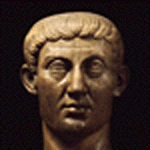 |
The Siege of Constantinople |
 |
|||||||
On the morning of April 2, 1453, the Monday after Easter, the vanguard of the army of the Ottoman Turks arrived before the walls of Constantinople. It was a small detachment of cavalry. A company of Greeks sailed from the city to drive them off. In the fierce short skirmish, several Turks were killed and many wounded before more Turks were galloping to reinforce their comrades. The defenders withdrew, and the Emperor Constantine XI ordered the bridges over the moat destroyed and the gates shut. For two days the defenders watched from their towers as the Turkish army massed - militia cavalry from every quarter of Ottoman Europe and Asia, regiments of the fierce and rapacious Bashazouks, the elite Sipahis cavalry in their bright silk tunics, and advanced elements of the proud Janissaries. They marched under fluttering pennants, weapons glinting, to the ceaseless beat of cymbals and drums. There were siege engines and endless columns of creaking ox-drawn carts, -among which was one cannon so enormous that the defenders could scarcely believe their eyes. It was a formidable champion to contend with the mightiest walls in the western world.
Between their encampments and the city, about 1,300 yards from the walls, the Turks dug a trench four miles long, piled the earth high into a parapet and erected on this a palisade. Behind this they made emplacements for their guns.
Most preparations were completed by Thursday when the Sultan Mohammed II arrived amid the splendor of his personal Janissary guards and entourage of government ministers and holy men.
The next morning Mohammed ordered his troops to their final positions. He also moved his luxurious red and gold tent forward to within a mile of the city in the pleasant valley of the small Lycus River which flowed through the city to the Sea of Marmora.
He watched impassively as a thousand Venetian sailors in their distinctive garb marched along the city's walls in a show of strength. Then he dispatched an emissary to the city under a flag of truce. In compliance with Islamic law, the emissary announced, the Sultan offered to spare Constantinople if it would surrender. If not, the city would be pillaged and the population massacred or enslaved.
The offer was stoutly rejected. The emissary returned to the Sultan's tent, and shortly afterwards the Turkish cannons boomed. The Siege of Constantinople had begun. It was a siege that all of a weak, divided and indecisive Europe hoped would never happen - a siege that a deluded continent believed could only fail. It was not only a siege by a new and vigorous political and military force rising from Asia to challenge the last besieged bastion of the once omnipotent Roman Empire of the East - an impoverished but still proud symbol of Western hegemony: the siege of Constantinople was also to be a cataclysmic battle between the Moslem and Christian worlds.
The list below gives, in order, the details of the Siege of Constantinople which marked the end of the Middle Ages.
Information for this story is from Ralph Vickers.